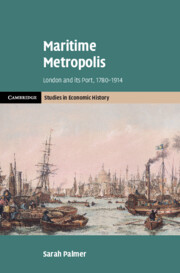
-
Select format
-
- Publisher:
- Cambridge University Press
- Publication date:
- November 2024
- November 2024
- ISBN:
- 9781108699365
- 9781108426534
- Dimensions:
- (229 x 152 mm)
- Weight & Pages:
- 0.6kg, 320 Pages
- Dimensions:
- Weight & Pages:
You may already have access via personal or institutional login
Book description
Nineteenth-century London was not only the greatest city of its time but it had an equally immense port. Although the relationship between the two physically shaped the city and profoundly affected the lives and livelihoods of its inhabitants, historians have always told their stories separately. Sarah Palmer's authoritative work instead paints a picture of London as a maritime hub driven by trade, shipping, marine insurance, shipbuilding and meeting the needs of seafarers ashore. Drawing on disparate archival materials from dock company records, the National Archives, the London Metropolitan Archives and more, she reveals both the economic importance of international and domestic sea-borne trade and the unique urban geography it created. In creating this more interconnected understanding of Britain's capital, Palmer argues that the nineteenth-century transition from sail to steam didn't just affect London's port, but transformed the city and its economy with an impact comparable to that of the railways.
Awards
Long-listed, 2025 Anderson Medal, Society for Nautical Research
Winner, 2025 Wadsworth Prize for Business History, Business Archives Council
Reviews
‘… both the most detailed study of the Port of London currently available, and an interesting read.’
Peter Stone Source: London Historians' Blog
Contents
Metrics
Full text views
Full text views help Loading metrics...
Loading metrics...
* Views captured on Cambridge Core between #date#. This data will be updated every 24 hours.
Usage data cannot currently be displayed.
Accessibility standard: Unknown
Why this information is here
This section outlines the accessibility features of this content - including support for screen readers, full keyboard navigation and high-contrast display options. This may not be relevant for you.
Accessibility Information
Accessibility compliance for the PDF of this book is currently unknown and may be updated in the future.


